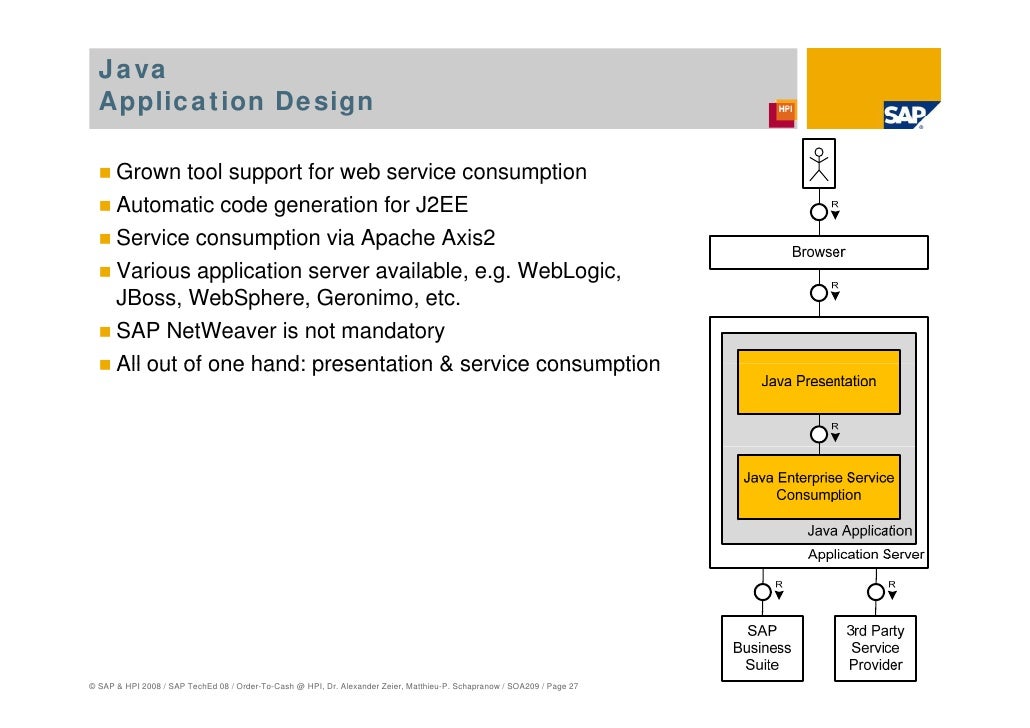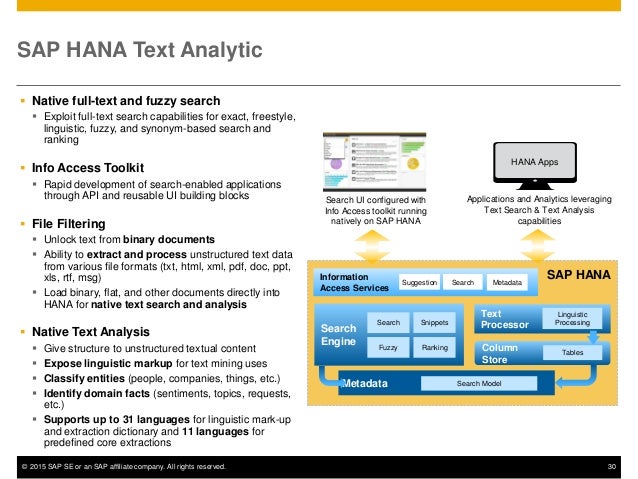Developing Enterprise Services For Sap Pdf Output
| Developer(s) | SAP SE |
|---|---|
| Written in | C, C++, ABAP/4[1] |
| Type | ERP |
| Website | www.sap.com/products/erp.html |
SAP ERP is an enterprise resource planning software developed by the German company SAP SE. SAP ERP incorporates the key business functions of an organization. The latest version (SAP ERP 6.0) was made available in 2006. The most recent Enhancement Package (EHP8) for SAP ERP 6.0 was released in 2016.[2]
Note: If you're looking for a free download links of Developing Enterprise Services for SAP Pdf, epub, docx and torrent then this site is not for you. Ebookphp.com only do ebook promotions online and we does not distribute any free download of ebook on this site.
Business Processes included in SAP ERP are Operations (Sales & Distribution, Materials Management, Production Planning, Logistics Execution, and Quality Management), Financials (Financial Accounting, Management Accounting, Financial Supply Chain Management), Human Capital Management (Training, Payroll, e-Recruiting) and Corporate Services (Travel Management, Environment, Health and Safety, and Real-Estate Management).[3]
Aylin Korkmaz Financial Reporting with SAP® Bonn Boston 391 Book.indb 3 8/8/11 4:08:29 PM. Develop the necessary service annotations and ontologies. Nor does it fully recognize the amount of effort. SAP's Enterprise Service Architecture (ESA) [17] and its. Composite Application Framework (CAF) [18]. Desired input and output parameters as well as on the state of affairs both prior to and after invoking the.
Development[edit]
An ERP was built based on the former SAP R/3 software. SAP R/3, which was officially launched on 6 July 1992, consisted of various applications on top of SAP Basis, SAP's set of middleware programs and tools. All applications were built on top of the SAP Web Application Server. Extension sets were used to deliver new features and keep the core as stable as possible. The Web Application Server contained all the capabilities of SAP Basis.
A complete architecture change took place with the introduction of mySAP ERP in 2004. R/3 Enterprise was replaced with the introduction of ERP Central Component (SAP ECC). The SAP Business Warehouse, SAP Strategic Enterprise Management and Internet Transaction Server were also merged into SAP ECC, allowing users to run them under one instance. The SAP Web Application Server was wrapped into SAP NetWeaver, which was introduced in 2003. Architectural changes were also made to support an enterprise service architecture to transition customers to a Service-oriented architecture.[4]
The latest version, SAP ERP 6.0, was released in 2006. SAP ERP 6.0 has since then been updated through SAP enhancement packs, the most recent: SAP enhancement package 8 for SAP ERP 6.0 in 2016

Implementation[edit]
SAP ERP consists of several modules, including Financial Accounting (FI), Controlling (CO), Asset Accounting (AA), Sales & Distribution (SD), Material Management (MM), Production Planning (PP), Quality Management (QM), Project System (PS), Plant Maintenance (PM), Human Resources (HR).[5] SAP ERP collects and combines data from the separate modules to provide the company or organization with enterprise resource planning.
Typical implementation phases:[6]
- Phase 1 – Project Preparation
- Phase 2 – Business Blueprint
- Phase 3 – Realization
- Phase 4 – Final Preparation
- Phase 5 – Golive Support
Output Configuration In Sap
Companies planning to implement or upgrade an SAP ERP system should pay strict attention to system integration to save their SAP ERP implementation from failure. With system integration in place, data flows move completely and correctly among various SAP ERP components, thereby not only streamlining business processes but also eliminating or minimizing redundant data entry efforts.[7]
Analyst firm Gartner estimates that 55% to 75% of all ERP projects fail to meet their objectives .. Of the top 10 barriers to a successful ERP journey, 5 can be addressed by developing and implementing a structured change management program.[8]

Deployment and maintenance costs[edit]
It is estimated that 'for a Fortune 500 company, software, hardware, and consulting costs can easily exceed $100 million (around $50 million to $500 million). Large companies can also spend $50 million to $100 million on upgrades. Full implementation of all modules can take years',[attribution needed] which also adds to the end price. Midsized companies (fewer than 1,000 employees) are more likely to spend around $10 million to $20 million at most, and small companies are not likely to have the need for a fully integrated SAP ERP system unless they have the likelihood of becoming midsized and then the same data applies as would a midsized company.[9]Independent studies have shown that deployment and maintenance costs of a SAP solution can vary depending on the organization. For example, some point out that because of the rigid model imposed by SAP tools, a lot of customization code to adapt to the business process may have to be developed and maintained.[10] Some others pointed out that a return on investment could only be obtained when there was both a sufficient number of users and sufficient frequency of use.[11][12]
SAP Transport Management System[edit]
SAP Transport Management System (STMS) is a tool within SAP ERP systems to manage software updates, termed transports, on one or more connected SAP systems. The tool can be accessed from transaction code STMS. This should not be confused with SAP Transportation Management, a stand-alone module for facilitating logistics and supply chain management in the transportation of goods and materials.
SAP Enhancement Packages for SAP ERP 6.0 (SAP EhPs)[edit]
The latest version (SAP ERP 6.0) was made available in 2006. Since then, additional functionality for SAP ERP 6.0 has been delivered through SAP Enhancement Packages (EhP).[13] These Enhancement Packages allow SAP ERP customers to manage and deploy new software functionality.[14] Enhancement Packages are optional; customers choose which new capabilities to implement.[15]
SAP EhPs do not require a classic system upgrade.[16]The installation process of Enhancement Packages consists of two different steps:
- Technical installation of an Enhancement Package
- Activation of new functions
The technical installation of business functions does not change the system behavior. The installation of new functionalities is decoupled from its activation and companies can choose which business functions they want to activate. This means that even after installing a new business function, there is no change to existing functionality before activation. Activating a business function for one process will have no effect on users working with other functionalities.[17]The most recent SAP Enhancement Package for SAP ERP 6.0 was EhP8, which was released in 2016. EhP8 delivers innovations and serves as a foundation to transition to SAP’s new business suite: SAP S/4HANA.[18]
See also[edit]
References[edit]
- ^Lextrait, Vincent (January 2010). 'The Programming Languages Beacon, v10.0'. Retrieved 14 March 2010.
- ^'Overview SAP Enhancement Packages - SAP Enhancement Packages - SCN Wiki'. wiki.scn.sap.com. Retrieved 2017-03-21.
- ^Boeder, Jochen; Groene, Bernhard (2014-03-06). The Architecture of SAP ERP: Understand how successful software works. tredition. ISBN9783849576622.
- ^Darmawan, Budi; Dvorak, Miroslav; Harnal, Dhruv; Murugan, Rennad; Silva, Marcos (2009). SAP Backup using Tivoli Storage Manager(PDF). ibm.com/redbooks. pp. 8–10. ISBN0738432970.
- ^'About SAP Modules - SAP Modules List Overview'. www.saponlinetutorials.com. Retrieved 2017-02-15.
- ^'Implementation Phases of SAP Projects (ASAP)'. University of Duisburg-Essen es/4students. Retrieved 2019-04-18.
- ^'Prevent SAP ERP implementation failure'. SearchSAP. Retrieved 2017-02-15.
- ^[1]
- ^Monk, Ellen F.; Wagner, Brej J. (2009). Concepts in enterprise resource planning (3rd ed.). Boston: Thomson Course Technology. pp. 23–34. ISBN978-1-4239-0179-2.
- ^Everett, Cath (2008-02-13). 'Companies warned over custom SAP costs'. UK: zdnet. Retrieved 2009-03-08.
Around 90 percent of European SAP customers could save six- or seven quid each year by avoiding the creation of bespoke code on top of the ERP platform, an IT consultant has claimed
- ^Vance, Ashlee (2003-03-31). 'SAP costs too much – customers ROI challenged'. UK: The Register. Retrieved 2009-03-08.
- ^'Nucleus Research finds 57 percent of SAP Reference Customers have not Achieved a Positive ROI'. Nucleus Research. 2003-03-31. Retrieved 2009-03-08.
Customers will see benefits after lengthy implementations, but many deployments anchored down by excessive consulting costs
- ^Harvey, Tesha; Schattka, Karin (15 December 2009). 'SAP ERP 6.0'. SAP Community WIKI. Retrieved 2 August 2017.
- ^Naveh, Moshe (24 December 2014). 'Overview SAP Enhancement Packages'. SAP Community WIKI. Retrieved 2 August 2017.
- ^Bui, Vi (11 January 2006). 'THE RELEASE CHANGE CHALLENGE'. Noventum. Retrieved 2 August 2017.
- ^Oehler, Christian; Weiss, Thomas (15 December 2009). 'Get Ready to Implement SAP Enhancement Packages for SAP ERP 6.0'. SAP Experts. Retrieved 2 August 2017.
- ^Thomas, Weiss; Christian, Oehler (1 January 2009). 'Innovation Without Disruption: A Deep Dive into SAP's Enhancement Package Strategy for SAP ERP'. SAPinsider. Retrieved 2 August 2017.
- ^Rau, Sabine (13 April 2016). 'SAP ERP Enhancement Package 8, what is new?'. SAP Blogs. Retrieved 2 August 2017.
Sap Output Type Configuration
- Gargeya, VB 2005, ‘Success and failure factors of adopting SAP in ERP system implementation’, Business Process Management Journal, Vol.11, No.5, pp501–516, Retrieved 21/04/2010.
- In White Paper Review, Industry Week OCT 2009, ‘ERP Best Practices: The SaaS Difference, Plex Systems, Retrieved 21/04/2012.
- Malhorta, A & Temponi, C 2010, ‘Critical decisions for ERP integration: Small business issues’, International Journal of Information Management, Vol. 30, Issue No.1, Pages 28–37, 21/04/2010, Science Direct.